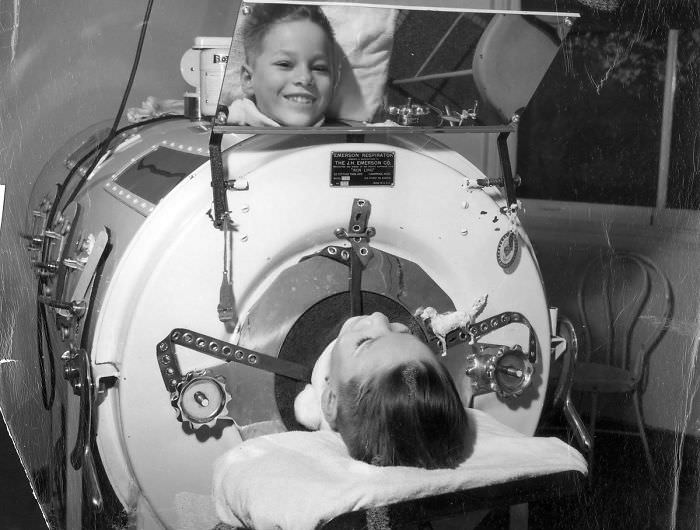
During the height of the polio epidemic in the early to mid-20th century, before the development of an effective vaccine in the 1950s, one of the most successful yet intimidating treatments for those affected by the disease was the iron lung. In 1952, the United States witnessed a peak of 57,628 polio infections, making it one of the most feared diseases of that time.
The iron lung was a large, metal, coffin-like cabinet designed to assist patients who could not breathe independently as a result of chest muscle paralysis caused by polio. The device worked by creating a vacuum around the patient’s chest, which would cause their lungs to expand and fill with air. When the vacuum was released, the patient’s lungs would naturally contract, allowing them to exhale. This process enabled the iron lung to effectively “breathe” for the patient.
Although the iron lung was a life-saving treatment for many polio sufferers, it was also a daunting prospect. Patients would have to remain inside the cabinet for weeks, months, or in some cases, their entire lives. Despite the intimidating nature of the device, the iron lung played a crucial role in saving thousands of lives during the polio epidemic. With the introduction of the polio vaccine, the need for iron lungs has significantly diminished, but they remain an important reminder of the advances in medical technology and the challenges faced during that era.



During the Vietnam War, I worked at the Texas Institute for Rehabilitation and Research in Houston. T.I.R.R. was originally called the Houston Polio Hospital because Houston had hundreds of cases of polio before the Salk polio vaccine was invented in 1954. Every year, the U.S. (as well as the rest of the world) got about 10,000 cases of poliomyelitis (also known as infantile paralysis, back then). The polio virus naturally lives in stagnant water, such as ponds and stock tanks, which meant swimming in slow-moving Southern rivers and creeks was pretty dangerous in the summer months (especially in the South). In 1960, there were only seven cases of live polio in the U.S., but thousands of people remained paralyzed and on crutches. Those who were totally paralyzed, living in an iron lung at home, and unable to breathe on their own were the worst cases. As an emergency technique, they used “frog breathing” where they repeatedly swallowed air into their lungs. As a paralyzed patient gets a cold or any kind of lung infection, they came into the hospital and were placed into an iron lung for rest and recovery. (An alarm goes off if the power fails, like a fire alarm.) During hurricane season, the iron lungs had to be pumped manually, using a lever on the bellows similar to a jack handle. Staff members took turns pumping the iron lungs, one or two hours at a time. When someone is paralyzed completely, it is usually for life. Pneumo-Belts were also available for people with partially paralyzed diaphragms. A small Samsonite suitcase contained a 12-volt air pressure pump that caused the person to breathe through a corset. Pumps on motorized wheelchairs were powered by car batteries. The picture shown must be an early version of an iron lung. There was an opening on the front end of our iron lungs for the patient’s head, and all the mechanical stuff, the motor, the bellows, etc. on the other end. They were painted an institutional “cream” color. To close the end cap, they used “dogs” (locks) like on a ship’s hatch. The patient’s neck area was sealed up with foam rubber and other things, similar to pillows. A change in air pressure within the iron lung caused the bellows to move in and out, sucking air into and out of the patient’s lungs. Within the iron lung, the patient was lying on a kind of stretcher tray that could be opened and the stretcher slid out for bed changes, bathing, toileting, etc. A coworker of mine who had caught polio as a child from the OPV (oral polio vaccine–an attenuated, live polio vaccine) wore full-length leg braces and used crutches. The sweetest girl I ever met, no bitterness, no anger about getting polio and being paralyzed. In the future, she attended Baylor University in Waco and Brigham Young University in Utah. She told me, “I’m not mad about the vaccine. I might have caught it anyway without the live, oral vaccine. It was just bad luck, like car crashes. The OPV saved thousands of lives, but it gave me polio. Most people were protected. However, God has a plan, and I trust in Him..”
There are still people living in iron lungs
A woman named Diane Odell died in 2008 when a generator that was supposed to power her iron lung failed during a power outage. She was in the iron lung for 58 years
How do you swallow anything with that thing forcing air into and out of your lungs uncontrollably??
It’s unbelievable that they haven’t come up with a better solution… Or maybe it’s just not worth the development cost.
There is a better way, iron lungs accomplish the same goal as modern ventilators.
Technically, iron lungs are better suited for prolonged use as they are less damaging to the respiratory system.
Negative pressure ventilation is more inconvenient for most, but this is probably outweighed by the benefits.
Honestly, I think he’d be better off with a modern ventilator anyway, since his lungs will never function independently. In contrast, modern ventilators weaken and eventually permanently disable the lung muscles if you come out of a coma. Iron lungs have one advantage: your lung muscles will still function if you come out of a coma. He already has a useless lung, so adding an iron lung would be pointless.
believe my aunt contracted polio in 1954. A lot of her time was spent in an iron lung. She suffered from paralysis in her legs, weakness in her arms, generalized muscle atrophy, and cardiomyopathy as a result of the virus. She was able to go to college and earn a degree in accounting even though she wore a back brace and used a wheel chair as an adult. After a long battle with heart failure, she passed away at the age of 28.
What did these kids do all day? While iron lunging, I’m curious if there was any form of education or entertainment.